- 2 April
- By Matt LaWell
- TeamJacksonville Suns
- LocationJacksonville, FL
- Tagged baseball widows, love, marriage
A lesson from a veteran

All baseball writers are at least a little unhinged.
You have to be to want to work nights and weekends, to grind along for 16 or 18 or 20 straight days in press boxes and airplanes, to spend half of every year on the road. There are always more calls to make, more stories to write. There never seems to be enough time for sleep. Oh, and the season starts in February and ends in December, in case you were wondering.
I learned all this and a scorebook full of other useful information from Dick Kaegel, the kind of baseball writer who still chomped on a cigar every day well into this century, one of the veterans who remembered when the press box was a place to drink and spring training was a place to work on your tan. He has spent 56 years pounding out bylines — the last nine covering the Kansas City Royals for MLB.com — which is impressive enough until you find out he turned 72 during the offseason. And that he covered every game last season. And that he did it with a new liver.
A septuagenarian organ transplant recipient covers 162 games in six months? Makes this whole adventure look a little less daunting.
But the most impressive part about Dick is the relationship he has built with his wife, Betty. They met at Kauffman Stadium nearly a decade ago when he still covered the team for the Kansas City Star and she still worked as the director of the Royals Charities. Their titles are different now, as is their relationship status. Every time I talk with Dick, he talks about Betty, and every time he talks about Betty, he still calls her his beautiful bride.
Carolyn and I had dated for about two months when I moved to Kansas City to cover the Royals for a season, and it was difficult. We probably would have fallen apart if she hadn’t worked to keep a new relationship alive across hundreds of miles. We probably would have lasted a month or two more if I had never seen Dick and Betty and their happy baseball marriage, not dampened by those nights and weekends and ridiculous runs of game days.
The women left behind every February by players, coaches, executives, writers, even fans, are referred to as baseball widows. In most circumstances, the separation is six or seven weeks before the season even starts. For married folks, it’s probably the hardest part of covering baseball. I remember, seven years ago, I was anxious for the season to start, to learn what I could before opening day. Dick and I exchanged emails, and I asked if we might be able to get together to talk. He apologized and said he would love to, but he would be in Kansas City only so many days between the end of spring training and a road trip to open the season. He needed to spend time with Betty.
Betty is not a baseball widow.
Neither is Carolyn.
Thanks, Dick. Best information you gave me all season.
Matt@AMinorLeagueSeason.com ♦ @MattLaWell ♦ @AMinorLeagueSeason
Photo courtesy of Baseball Pilgrimages
- 30 March
- By Matt LaWell
- TeamLake County Captains
- LocationEastlake, OH
- Tagged Cleveland, drums, heartbeats
BOOMBOOMBOOMBOOM!
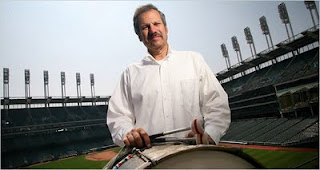
What do we talk about in Cleveland when we talk about John Adams? Metal bleachers, for starters, summer afternoon games, late rallies that never seem to last long enough, every one of them punctuated by the steady rhythm of old mallets on the face of a big, beautiful bass drum.
We talk about what it means to be a fan.
John Adams has next to nothing to do with the minor leagues. He might have hauled his drum with him through the turnstiles of a few minor league stadiums, Classic Park in Eastlake or Canal Park in Akron, but his legacy was established long ago in the top row of the bleachers at Municipal Stadium in Cleveland.
He played his drum for the Indians and their fans for the first time in August 1973. During the nearly four decades since then, he has played at more than 3,000 games. For a while, when the Indians sold out 455 straight games, he purchased two tickets -- one for him, another for his drum -- before a group of nuns raised funds for at least one of his season tickets. Every May, he plays for runners pushing along the Cleveland Marathon course, an adrenaline boost during hours otherwise filled with pain. He has hurled a ceremonial first pitch, been immortalized by a bobble-arm doll, been cheered by hundreds of fellow drummers during a pregame ceremony at Progressive Field. No matter how few fans show up at the stadium, Adams almost always does. His absence is a bigger story than his attendance.
So why write about Adams here, where our focus is the minors, when he is very much major league? Because, with less than a week until opening day, he’s in the news again, the inspiration for a new beer -- Rally Drum Red Ale -- about to be tapped by Great Lakes Brewing Company in the city where he works, lives, loves. That seems the obvious reason. Less obvious is because, after listening to him keep the beat at two stadiums across the last 22 years, Adams captures what it means to be a fan.
There are others like him at stadiums all across the nation -- like the late Freddy Sez in New York, the smoldering Toast Man in Charleston, the unforgettable and irresistible Annie Savoy in old Durham -- and all of them are ambassadors for their favorite team and for the game. Along the Lake Erie shore, Adams is an ambassador who provides a literal rallying cry, one note at a time. Parents march their children 25 rows up the bleachers to meet him, to shake his hand, to ask him -- most of the time rather timidly -- if he might let them carry a beat or two. Often, he says yes. Twentysomethings make the climb, too, a couple of beers in their gut, and ask for the same opportunity. Often, he says no, but he still talks with them.
On most nights this season, maybe in the early innings, especially in the late innings, always with a runner or two on base, he will pick up his mallets and pound out deep notes that fill a stadium, that echo over radios across 39 states and half of Canada -- Boom! Boom! Boom! -- and he will cheer his own way -- BOOM! BOOM! BOOM! -- the only way he knows -- BOOMBOOMBOOMBOOM! BOOMBOOMBOOMBOOM! BOOMBOOMBOOMBOOM! -- the only way most fans in Cleveland have ever known.
His is the heartbeat of a team, of a city. BOOM! Boom!
Boom.
Matt@AMinorLeagueSeason.com ♦ @MattLaWell ♦ @AMinorLeagueSeason
Photo courtesy of LetsGoTribe.com
- 29 March
- By Matt LaWell
- TeamJacksonville Suns
- LocationJacksonville, FL
- Tagged baseball, music, pop culture
One week

Fourteen years ago, Ed Robertson and Steven Page scribbled the 594 words that would become their biggest hit and their single lasting influence on popular culture. Some of those words shared a story, others were just nonsensical nonsequiturs, but all of them -- to the ears of teenage nerds everywhere and, for seven glorious days, the rest of the world -- were perfect. Robertson and Page were the founding members of Barenaked Ladies. And their hit?
All of which is a longwinded way to say that in one week, we'll be at the Baseball Grounds of Jacksonville, a new brick stadium with green iron gates and a picnic pavilion filled with palm trees and pennants stretched across the outfield wall. In one week, there will be games to play and stories to tell, a season on the road with no set plans other than the next city on the schedule. In one week, thousands of young men will be on the field and thousands more people will cheer them and boo them and ignore them altogether for another hot dog and the tricycle race in the middle of the fourth inning.
Before much longer, less than one week, there will be more stories right here -- on this site, on this blog, over on Twitter in some sort of micro form -- that aim to answer the question we posed months ago: What does minor league baseball mean today? I don’t know that we can find an answer in five months, but I hope we do. I hope we find hundreds of answers. I hope you help us find some of them.
A lot can happen in a week. A lot more can happen in a season.
Matt@AMinorLeagueSeason.com ♦ @MattLaWell ♦ @AMinorLeagueSeason
Photo by Matt LaWell
- 28 March
- By Carolyn LaWell
- TeamFrederick Keys
- LocationFrederick, MD
- Tagged baseball, national anthem, songs
O say, can you see ...
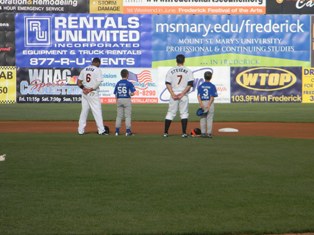
Before the first pitch, jump ball, kickoff, puck drop, there’s the National Anthem. It’s the signal we now know as the opening to sporting events around the country. It’s a sporting tradition with roots nearly a century old and one that, actually, dates back to one summer day at a baseball stadium.
It was the first game of the 1918 World Series. Babe Ruth was on the mound tossing warm-up pitches in the middle of the seventh inning and the brass band in the stands started playing Francis Scott Key’s “The Star-Spangled Banner.” As the story goes, fans immediately joined in signing. On that day, almost 104 years after Key penned the lyrics, a game-day tradition was born with the Boston Red Sox.
Now the performing of the song prior to the start of every baseball game didn’t start until decades later, during World War II, and it was adopted even later by all professional sports. But it’s a tradition so rooted in baseball that the Baltimore Orioles High-A affiliate, the Frederick Keys in Frederick, Md., are named after Key, a native of the county.
In recent weeks, minor league teams have held auditions to finalize this year’s anthem singers. And in reading the calls for locals to tryout, we realized that hearing the National Anthem 120 times at 120 baseball games is something we’re looking forward to experiencing this season.
We’re looking forward to meeting the talented individuals who -- much braver than we could ever be -- take the field to sing and play the most analyzed song on our country’s play list. We’re looking forward to hearing each rendition, with their different lengths and notes. And we’re looking forward to crowds of thousands briefly going silent upon hearing the words “Please rise for the playing of our National Anthem.”
Carolyn@AMinorLeagueSeason.com ♦ @CarolynLaWell ♦ @AMinorLgSeason
Photo courtesy of the Frederick Keys
- 27 March
- By Matt LaWell
- TeamJacksonville Suns
- LocationJacksonville, FL
- Tagged lists, maps, teams
Now name them all

Just how many minor league baseball teams are there?
Well, that depends. Are we talking about the teams that play a full season of 140 or so games? Or do we want to include the teams that start in June, after the annual player draft, and play a short season for a couple of months until Labor Day? Are we talking about just those teams affiliated with major league teams? Or do we want to tack on independent teams? International teams? Summer league teams? There a lot of minor league baseball teams. Just a lot.
We plan to see 120 of them -- every team that plays a full season and has a major league affiliate -- in 152 days. If we were just traveling and not writing, filming, shooting and interacting with folks over on Facebook and Twitter, we might be able to get to a dozen or so more teams and stadiums, but five months flies by pretty quickly.
Also, Tacoma is just a ridiculous distance from every other city on our route.
So as the offseason continues to wind down, enjoy this somewhat thorough breakdown of the minors:
♦ ... Minor league teams that play a full season and have a major league affiliate: 120
♦ ... that are independent: 68
♦ ... that play a short season and have a major league affiliate: 40
♦ ... that play in the Dominican Republic or Venezuela: 39
♦ ... that play a short season, have a major league affiliate and play in their parent club’s spring training facility: 27
♦ ... that play in Mexico: 16
Which brings us to a more-or-less official total of 310 ... which is definitely not possible in one season. No, not even if you fly.
(Special thanks to Hebderg Maps, which produces all sorts of fun maps every year, including a Baseball Travel Map that has been in our car for a year and is already curled and wrinkled and wearing away in certain spots. We bought it in Round Rock last April and probably would have been able to plan all this without it, but not nearly as easily.)
- 26 March
- By Carolyn LaWell
- TeamLake County Captains
- LocationEastlake, OH
- Tagged brackets, mascots, Olympus
Six feet of green fuzz can be fun, too
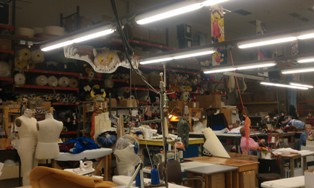
Skill, heart and sheer will mean everything on the basketball court this month. But one radio station has eliminated all that from its own Madness.
The Source -- KCUB-AM 1290 on your dial in Tucson, Arizona -- searched for what it refers to as “unique and popular mascots” across the United States and Canada, and is currently winnowing the field in a Mascot Madness online vote.
The intrigue of the bushy, big-headed bracket -- which is down to an elite eight today -- is who the station selected. A couple of college mascots made the cut, including Wilbur the Wildcat of the local University of Arizona, but the bulk of the field is filled with mascots of minor league teams we’ll see at some point this season.
For many fans in minor league cities, the players are a shuffle of talent that never remains the same month to month, much less season to season. They're young men the fans can cheer and follow for a little while. But for most folks, especially the kids in the parks, the mascots are the real stars.
Last season, during a game at Classic Park in northeast Ohio, two brothers barely big enough to weigh down their seats were sitting behind us. They didn’t care about the great infield plays, the players crossing home or the constant lead changes. The only words out of their mouths were “fireworks” and “Skipper” -- the green, fuzzy, 6-foot mascot who eats hot dogs, throws T-shirts and dances on the dugouts. And you better believe both of those boys went home with Skipper dolls, which retail for about $15.
Because mascots are a constant presence and are highly visible in smaller stadiums, they are a marketing force -- and the minors have embraced that. The mascot is a big part of the experience of going to a game, or even following the team from home. Need proof? Parker, the mascot for the Fresno Grizzlies, has his own Twitter handle (though he seems to have taken a break during the offseason).
We’re looking forward to meeting -- and maybe sharing a hot dog or two -- with Bolt in Winston-Salem, Johnny in Fort Wayne, Nutzy in Richmond and plenty of other colorful (and colorfully named) mascots. Maybe we’ll even have a chance to try on a suit and see what it feels like to wear all that fuzz on a 100-degree day.
Love mascots? Look for our story about Olympus Group later this season. Olympus is one of the larger manufacturers of major and minor league baseball mascot costumes -- they count the Milwaukee Brewers sausages and the Cleveland Indians hot dogs among their creations -- and the good folks at their Milwaukee headquarters (see photo above) were gracious enough to give us a factory tour we’ll never forget.
Carolyn@AMinorLeagueSeason.com ♦ @CarolynLaWell ♦ @AMinorLgSeason
Photo by Matt LaWell
- 23 March
- By Matt LaWell
- TeamTampa Yankees
- LocationTampa, FL
- Tagged baseball, food, local
No one can eat hot dogs every day

A little more than a year ago, the last time the Baseball Winter Meetings shared a lobby with Disney and the Mouse, I sat in a booth in Columbia, a Cuban restaurant famous in Florida with a handful of locations dotted around the state, and watched baseball men sit and talk about their players and their teams and how to win.
One night, Seattle general manager Jack Zduriencik shared a table with his manager, Eric Wedge, and a couple other Mariners executives. The next night, Nolan Ryan, an owner of the Rangers for less than five months at the time, walked in, the last man to arrive at a table filled with Texas honchos. Cleveland manager Manny Acta lives near the restaurant and said he eats there regularly during the offseason. I did not, unfortunately, note whether any of them favor chicken and rice, or black bean soup, or Columbia’s renowned 1905 Salad. I should have.
The reason so many baseball folks eat at Columbia? A nice atmosphere, of course, and excellent service. But the most important reason is far simpler.
Good food.
Carolyn and I love good food, too, which is why restaurants -- high and low cuisine, though normally somewhere in the middle -- will play a starring role here on the blog. We have plans to eat at Columbia again in April, our favorite Chicago pizzeria in June, one of the top new restaurants in the South in July and the best little hamburger stand in North Carolina in August. Along the way, there will be dozens of other unplanned stops. We look forward to every one of them.
We rely on locals for recommendations, so if you want to suggest your favorite spot, and maybe even join us for a meal, send us an email. We would love to break bread -- or just about any other food -- with you.
Matt@AMinorLeagueSeason.com ♦ @MattLaWell ♦ @AMinorLgSeason
Image courtesy of Columbia Restaurant
- 22 March
- By Matt LaWell
- TeamLake Elsinore Storm
- LocationLake Elsinore, CA
- Tagged promotions, Tebow, trades
Tebow on first? Why not?
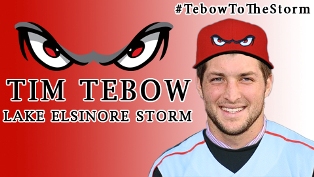
Earlier this week, the Dayton Dragons grabbed headlines whenSportsBusiness Journal nominated them as the first minor league team up for their prestigious professional team of the year award. Later, for an hour or two, at least, the Lake County Captains grabbed a few more headlines after they unveiled a four-pound fish sandwich.
And then the spotlight turned to Tim Tebow.
Tebow was a Denver Bronco, and was rumored to be on the brink of becoming a Jacksonville Jaguar or a Miami Dolphin or a New England Patriot before ultimately landing in New York, a Jet by trade. But not before at least one minor league team tried to have a little fun with an otherwise tenuous situation.
The Lake Elsinore Storm, the defending California League champions and owners of one the more recently iconic minor league caps, offered the Broncos two mascots and the naming rights to their stadium. The Storm issued a humorous news release, the local media picked up the story, then the national media ran with the whole promotional swap. One blogger tweeted he “would pay at least $3 to see Tebow play minor league baseball. Maybe $4.” A local sports columnist quipped “Tebow is at his best when he runs the ball up to the plate.”
Tebow never came close to playing for the Storm this season, of course. But how much attention did the team garner for itself for next to no cost? Lake Elsinore might not land on national television again all season, but it did this week? Like the small school that crashes the NCAA Tournament and sticks around for a while, the Storm wound up with something it could have never otherwise purchased.
Soon enough, in just two weeks now, the games will start. For now, the promotions are enough.
Matt@AMinorLeagueSeason.com ♦ @MattLaWell ♦ @AMinorLgSeason
Photo courtesy of the Lake Elsinore Storm
- 21 March
- By Matt LaWell
- TeamDelmarva Shorebirds
- LocationSalisbury, MD
- Tagged home runs, Christmas, love
A minor league love story
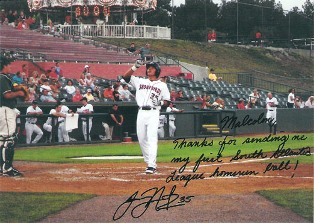
In the second inning of a game late last June, a young outfielder named Jeremy Nowak hit a home run for the Delmarva Shorebirds. The home run arced over the Perdue Stadium wall near the scoreboard and landed in packed dirt, not far from at least one stubbed cigarette butt. When Jeremy crossed home plate, he helped the Shorebirds tie the Greensboro Grasshoppers.
That was the only run Delmarva scored all night. The Shorebirds beat the Grasshoppers the next two nights, but by then, almost all of the 1,825 people who had watched Nowak hit that home run had forgotten about it.
Except for a man named Malcolm MacMillan and a woman named Alicia.
Malcolm is a tremendous fan of the minors. He travels from city to city, state to state, and writes about stadiums for his site, The Ballpark Guide. Alicia is Jeremy’s girlfriend.
On that June night, Malcolm wandered from his seat in the eighth inning out near the spot where Jeremy’s home run had landed. It was still there, so he snapped a few photos for a story and took it with him. When he learned it was Jeremy’s first homer in the South Atlantic League, he reached out to the Shorebirds on Twitter, hoping to return it the next day, but never heard from the team. He never heard from anybody, in fact, until Alicia sent him an email in December.
And this is where the love story starts. Alicia said she had read Malcolm’s story about the game and the homer, and she asked if Malcolm would mind sending her the ball so she could give it to Jeremy for Christmas. “I know it would mean so much to him,” she wrote. So Malcolm put the ball in a box and mailed it quickly enough for it arrive under the tree. A few weeks later, Alicia thanked Malcolm in a long email and Jeremy mailed a package, complete with an autographed photo of the home run and a thank you that called the ball “the greatest Christmas gift I have ever received.”
Jeremy turned 24 last week, old enough to play baseball for at least a few more seasons, young enough to have a lot of life in front of him. After a couple of seasons with Aberdeen and Delmarva, he has a low batting average and a handful of homers. But he also has good gap power and speed on the bases, as reflected by 16 doubles and 10 steals last season in 62 games with the Shorebirds.
More important, he has an incredible girlfriend.
How many women would track down one person who had a home run ball that would mean the world to their boyfriend and another person who had snapped a photo seconds after the blast? (Yes, Alicia later found another fan at that June game who had snapped a photo of Jeremy, the same one at the top of this story -- which actually includes Malcolm, the man in the yellow shirt in the top row of seats.) How many young couples can create a bond forever over a cork, some cowhide and 108 double stitches?
I’ve never met Jeremy or Alicia -- and the only reason I know their story at all is thanks to Malcolm -- but how can I not root for him to keep climbing the Orioles’ organizational ladder, from Delmarva to Frederick, from Bowie to Norfolk. And how can any of us not root for him to do it with Alicia?
Matt@AMinorLeagueSeason.com ♦ @MattLaWell ♦ @AMinorLgSeason
Photo courtesy of Malcolm MacMillan
- 20 March
- By Matt LaWell
- TeamDayton Dragons
- LocationDayton, OH
- Tagged sellouts, awards, baseball
Minors can teach the majors plenty

The Dayton Dragons are in the news again, which isn't much of a surprise. The team has received national attention during much of the last year for its record sellout streak, its passionate fans and its status as one of the elite teams in all of the minors, regardless of its place in the Low-A Midwest League, four big steps from the majors.
What is a surprise is that this bit of news comes from SportsBusiness Journal, the top source of news in the industry, which announced Tuesday that the Dragons were among five finalists for its annual award for professional sports team of the year. Make no mistake, the Dragons were good last year. They won 48 games in the first half, finished the season with an 83-57 record and posted some ridiculous statistics, like 103 steals from shortstop Billy Hamilton, 14 shutout wins and a 3.39 team ERA.
Their biggest number, though, was 843 -- the number of consecutive sellouts at Fifth Third Field since the park opened 12 years ago. That alone was probably enough for the Dragons to be nominated -- along with the Texas Rangers, Boston Bruins, Stewart-Haas Racing and Sporting Kansas City -- and to be the first minor league team in any sport to receive a nomination from SBJ for the award.
There will be a winner named Memorial Day weekend at a fancy hotel in New York, and the odds are against the Dragons. But this -- the nomination, the recognition, the moment in the spotlight with the best teams in the majors -- is proof enough that some minor league teams can compete with the majors, and maybe even show some better ideas and practices.
We head to Dayton for a game on July 21 -- sellout No. 894, barring rainouts -- and I cannot wait to hear the cheers of thousands of fans who Major Leaguers like Jay Bruce still rave about years after their last game in a packed stadium in Dayton.
I cannot wait to see, on a much smaller scale, what the majors could look like.
Matt@AMinorLeagueSeason.com ♦ @MattLaWell ♦ @AMinorLgSeason
Photo courtesy of the Dayton Dragons